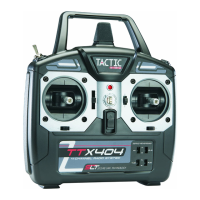10
switch harness for optimum weight distribution in the model. Locate the switch well
away from the propeller and the exhausts from a glow engine. Cut a hole in the side of
the fuselage large enough to allow the switch’s lever to move freely and fully from end-
to-end. If the switch harness includes mounting screws, be sure not to cut the hole so
long that it would prevent the mounting screws from being installed fi rmly.
One switch harness lead connects to the receiver’s “BAT” socket, another connects
to the battery, and the third lead is for convenient recharging of the battery through
the switch harness. Charging of the rechargeable battery through the switch harness
can only be accomplished when the switch is in the OFF position.
Use of “AA” NiCd or NiMH rechargeable cells is recommended. Do not use alkaline
cells for powering the receiver and servos. See the SERVOS AND ACCESSORIES
section on page 16 for a full list of optional batteries and chargers.
IMPORTANT! Always make sure that power is applied to the
transmitter BEFORE applying power to the receiver and servos,
and that the throttle stick is at minimum (idle) position. Failure
to do so could result in the model becoming uncontrollable and
cause a safety hazard.
BIND THE RECEIVER TO THE TRANSMITTER
For proper operation it’s necessary to “bind” the Tx and Rx together electronically.
This ensures sole communication between the two, and prevents other transmitters
from being able to control the receiver.
1. Turn on the Tx.
2. Apply power to the Rx.
3. If the Rx LED fl ashes once and then stays on, the Rx is already bound to the
Tx and you can skip to the next section. Otherwise, insert a small diameter
screwdriver through the hole marked “BIND” and press the pushbutton until
the Rx LED glows red and then turns off after about one second.
4. Release the “BIND” button.
5. If the binding is successful, the Rx LED will fl ash once and then remain ON.
6. Test for proper Tx/Rx functionality in the next section. If the radio doesn’t
appear to have become properly binded, repeat steps 1–6 above.
SYSTEM CHECK AND OPERATION
WARNING! During all pre-fl ight preparations with the aircraft on the
ground, make sure the throttle stick remains at the minimum position
and do not stand the Tx upright on the ground. Carefully lay the Tx on

